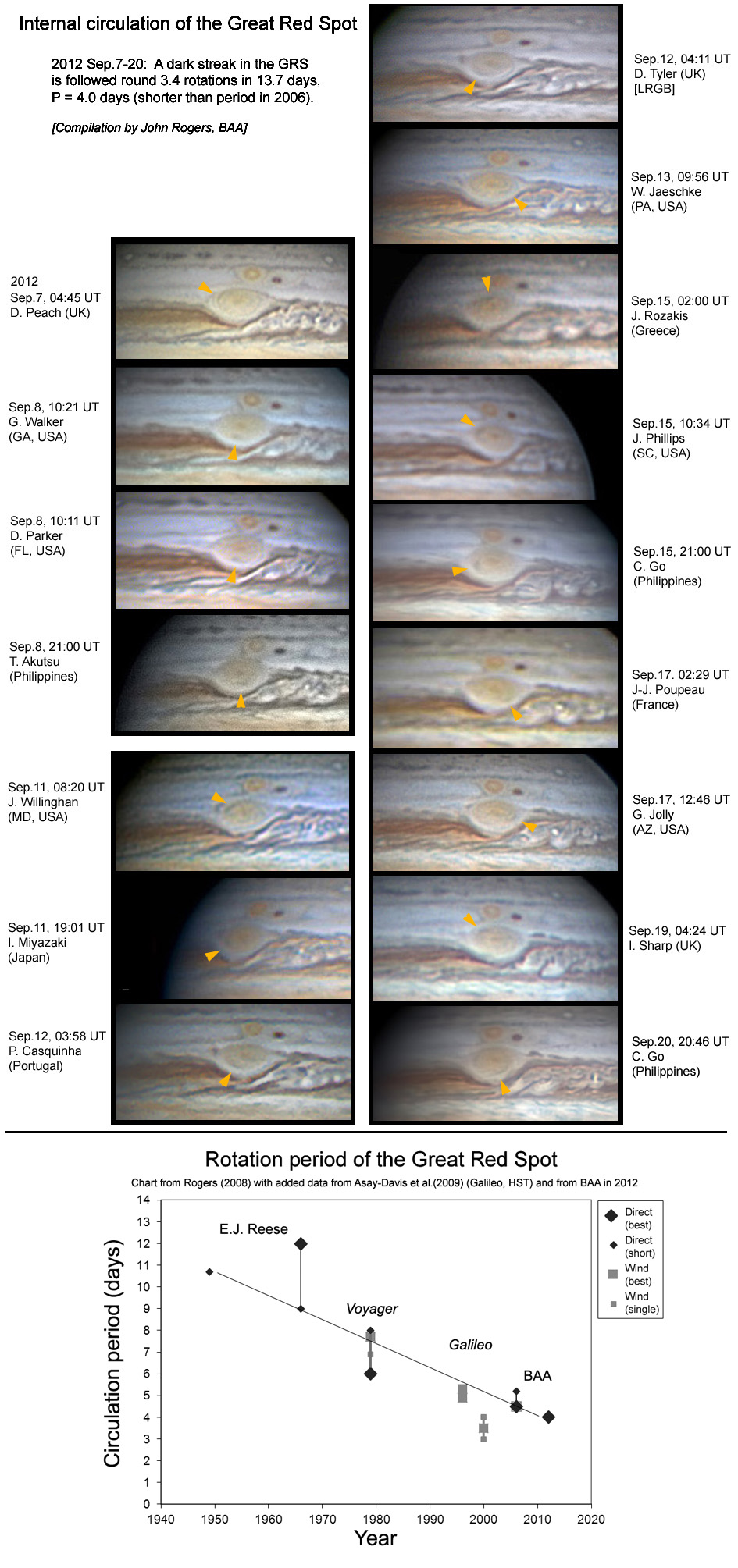Circulation of the GRSOctober 31, 2012
|
|---|
|
Japanese
Hello all, Here is another exciting result from the sets of images which we posted 2 days ago:
The accelerating circulation of Jupiter's Great Red SpotWe published a paper with this title based on images taken in 2006 [ref.1]. Now, recent images again allow the GRS circulation to be traced, and show that it has continued to accelerate. The attached compilation is from the image sets that were just posted in Report no.6. There is a dark streak circulating within the GRS, indicated by a yellow arrowhead. Note how it returns to the same position on the mornings of Sep.7,11,15,19. It is tracked 3.4 times around the GRS in 13.7 days, giving a rotation period of 4.0 days (+/-0.1 day). This period is significantly shorter than the period we established in 2006 (4.5 days). The GRS has not shrunk much in the meantime, but our deduced wind speed has increased from ~112 to 135 m/s [see footnote]. Although we cannot be certain that any feature visible from Earth is moving with the maximum wind speeds, the periods we observed in 2006 and 2012 agree well with the trends from spacecraft [ref.2]. The rotation period, as shown in the chart, is diminishing at about the same rate as the radius of maximum wind speeds, as determined by spacecraft [ref.2]; the outer radius of the GRS is shrinking at a rather slower rate. The maximum wind speeds fluctuate in spacecraft data, and do not show a clear trend. We can conclude that the speeding up of the circulation period is due mainly to contraction of the circulation itself, and that this trend is still continuing this year. It is amusing to note that the GRS now has exactly the same circulation period and the same north-south diameter as the atmosphere of Venus.
John Rogers,
Footnote:The length of the GRS (major axis of the oval, ignoring the variable grey collar around it) in 2012 Sep. appears to be ~16-17 deg., though the edges are not very distinct; the average of measurements by the JUPOS team is 14.5 deg. A more precise value can be obtained from images in late 2011, as the internal diameter of a uniform dark collar: 16 deg, or 15.4 deg from JUPOS measurements. Here I adopt 16 (+/-1) deg. as the present length. Note that this is not significantly shorter than in 2006. The wind speed is calculated by adopting a length of 16 deg = 18560 km, assuming a constant N-S width of 10.3 deg = 12400 km, noting that the dark streak is at ~80% of the radius of the GRS, and using the same formula as in ref.1; thus we obtain a maximum speed of 135 m/s. This is significantly faster than the value of 112 m/s we found in 2006 [ref.1], but agrees with the values of 118-132 m/s reported from HST images in 2006 [ref.2].
References:
[1] Rogers JH (2008) JBAA 118, 14-20: [2] Asay-Davis XS, Marcus PS, Wong MH & de Pater I (2009) Icarus 203, 164-188.
Illustration:Top: Set of images of the GRS in 2012 Sep., from the same images that were posted in report no.6. There is a dark streak circulating within the GRS, indicated by a yellow arrowhead. South is up. Bottom: Chart showing all determinations of the GRS rotation period, as in ref.1, plus data derived from ref.2, and our latest result. Diamonds represent direct measurements of the period (large points, over several rotations; smaller points, over shorter intervals); squares represent periods calculated from maximum wind speeds observed from spacecraft (large points, from best fits; smaller points, from single values). Apart from the value from Galileo on 2000 May 22 (when the wind speed seems to have been anomalously fast), there is a linear trend to shorter rotation periods.
|
 Click to original size |
|
_______________________________ John H. Rogers, Ph.D. Jupiter Section Director, British Astronomical Association jhr11@cam.ac.uk http://www.britastro.org/jupiter/ _________________________________
|
大赤斑の循環気流
|
|
皆さんへ、 これは2日前に公開した画像から得られたもう一つの興奮する結果である。
木星の大赤斑の加速する循環気流我々は、2006年に撮影された画像に基づいて、このタイトルの論文を発表した[文献1]。現在、最近の画像から再び大赤斑循環気流を追跡することができ、加速し続けていることが分かった。添付した組画像は、Report no.6でまさに公開した画像セットからのものである。黄色矢印で示すように、大赤斑内部を循環するダークストリークがある。9月7,11,15,19日の朝にストリークが同じ位置に戻っていることに注目すべきである。ストリークは13.7日で大赤斑の周りを3.4回追跡されて、このことから自転周期4.0±0.1日が得られる。 この周期は、我々が2006年に立証した周期(4.5日)より著しく短い。その間に大赤斑はあまり縮小しなかったが、我々の推定風速は約112m/sから135m/sに増加した[脚注]。地球から見える全ての模様が最大風速で移動しているかどうかを確認できないけれども、2006年と2012年に観測した周期は、探査機からの傾向と良く一致している[文献2]。チャートに示す自転周期は、探査機が決定したように、最大風速の半径とほぼ同じ率で減少している[文献2]。大赤斑の外径はかなりゆっくりと縮小している。最大風速は探査機データで変動して、はっきりとした傾向を示していない。我々は、循環周期の加速は主に循環気流自体の収縮によるもので、この傾向は今年も続いていると考えている。 現在、大赤斑が金星の大気とまさに同じ循環周期や同じ南北直径をしていることに注目すると面白い。
John Rogers
脚注エッジはあまりはっきりとしないけれども、2012年9月の大赤斑の長さ(楕円の長径、大赤斑の周りの変動する灰色の襟を無視する)は約16-17度に見える。JUPOSチームによる測定の平均は14.5度である。より正確な値は2011年後半の画像から得られ、均一な灰色の襟の内径として、JUPOS測定からは16度あるいは15.4度である。そこで私は現在の長さとして16±1度を採用する。これは2006年より著しく短くないことに注目すべきである。 風速は、長さ16度=18560kmを採用し、一定の南北幅10.3度=12400kmを仮定し、ダークストリークが大赤斑の半径の約80%であることに注意し、文献1と同じ公式を用いることで計算できる。こうして我々は最大風速135m/sを得た。これは2006年に発見した値112m/sより著しく速いが、2006年のHST画像から報告された値118-132m/sと一致している。
参考文献
[1] Rogers JH (2008) JBAA 118, 14-20: [2] Asay-Davis XS, Marcus PS, Wong MH & de Pater I (2009) Icarus 203, 164-188.
イラスト上: report no.6に公開されたのと同じ画像から、2012年9月の大赤斑の画像セット。これは黄色の矢印で示す、大赤斑内部を循環するダークストリークである。南が上。 下: 大赤斑の自転周期の全ての決定を示すチャート、文献1と同様で、文献2から導かれたデータと我々の最新結果を加える。ダイヤモンド(◆)は周期の直接測定(大きな点は複数の自転、小さな点は短い間隔)を示し、四角(■)は探査機から観測された最大風速から計算された周期(大きな点はベストフィットから、小さな点は単一の値から)を示す。2000年5月22日のガリレオ探査機からの値を別にして(風速が異常に速かったように思われる時)、短い自転周期には線形の傾向がある。
|
 Click to original size |
|
_______________________________ John H. Rogers, Ph.D. Jupiter Section Director, British Astronomical Association jhr11@cam.ac.uk http://www.britastro.org/jupiter/ _________________________________ 【日本語訳:伊賀祐一】 |